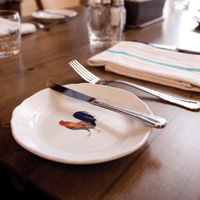Funky tableware has been replaced with simple white accents and green-friendly tabletops
Like any great artist, chefs crave a blank canvas to showcase their creations. So, after a handful of out-of-the-box experiments, tabletop designs are reverting back to the basics, with simple white or white-embossed dishware as well as standard flatware and glassware.
That doesn’t mean creativity has fallen by the wayside. New shapes — from teardrop and asymmetrical-shaped bowls to rolled-edge rectangular plates and serving platters — can deliver the odd eye-popping 3D visual effect.
But, plates, glasses and cutlery aside, in recent months the tabletop itself has become the star
of the show, offering rustic charm with a green-friendly message.
Overall, it comes down to topping a table modestly in a world where margins are tight, competition is tough and customers are more discerning. “It’s looking for a perceived value,” says Bill Horosko of Tableware Solutions in Mississauga, Ont. “You are looking for the wow factor.”
Shapes and colours
In the past few years, squares and rectangles have become common, but more recently demand is growing for softer edges and corners that offer a curvature, reports Horosko. “The round plate is still the foundation piece. But it’s all about augmenting it with something more exciting.” With the exception of a few cast-iron pieces for dishes such as macaroni and cheese, “it’s 95 per cent white or embossed white.”
A simple design lends to creative plating, says Jay Tanuwid-jaja, executive chef for Hotel Le Germain Maple Leaf Square in Toronto. “The days of the funky glass and designer china have passed. Chefs like things as simple and clean as possible. We want the focus to be more on the food, not the china.”
Richard Pitteway, food and beverage manager for The Humber Room restaurant in Toronto agrees. “Chefs love a palette they can work from so they can get more inspired.”
The college restaurant, located in Toronto’s Humber College, introduced a new tableware selection in partnership with Tableware Solutions. Beyond the basics, they opted for different shaped bowls with sloping edges. “They add character and can be used with more basic plates,” Pitteway explains. “We also have some beautiful square plates with rolled edges that make a striking statement. You can do so many textural things by mixing and matching shapes.”
Size matters
Table presentation is at the centre of a margin-building strategy. “Restaurateurs are making presentations on smaller surfaces or looking at things to make the plate look great as an accompaniment to the food. It’s actually quite cost effective to put your efforts into your tabletop presentation,” says Joel Sisson, consultant with Crush Strategy Inc. in Mississauga, Ont.
Operators used to pick up one-off tableware items for a specific dish that made a big statement at the table (remember miniature woks?), but now “They’re moving away from those items because they’re expensive and take up a lot of space in the kitchen,” Sisson says.
Sizes are changing ever so slightly as a subtle means of reducing portions to widen margins. “When you give creativity to your plate presentation, it allows you to serve less and charge more because the perception of quality is higher,” explains Sisson. “You can go from an eight-ounce to seven-ounce burger — which might be a little bit thinner — but if you change the plate and present it well, no one notices,” he says. “Longer, thinner serving dishes, for example, can make it look like there’s more on the plate.”
French fries are one area where presentation trumps quantity, he adds. “A lot [of operators] are playing with cone spirals or galvanized steel buckets that hold about six ounces rather than the usual eight to 11 ounces. It punches up the look of the plate without taking away from the experience.”
The same economics are being applied to glassware. “Many have gone to 18-ounce rather than 20-ounce draft beer glasses, because it makes for better margins and customers don’t really notice,” says Sisson.
Through the drinking glass
One new trend fuelling beverage sales is nucleation, a process whereby laser etching at the bottom of a flat glass offers a rougher surface that promotes a greater release of carbonation in drinks such as beer and sparkling wine. While the design doesn’t change the taste, it does provide a wow factor in presentation.
But, when it comes to the glass design, operators are becoming more practical and more about basic varietal wine and cocktail glasses. “We keep glassware pretty much standard throughout the hotel,” Le Germain’s Tanuwidjaja notes. “The cost of using 100-per-cent crystal is enormous.”
For the Halifax-based RCR Hospitality Group’s upscale restaurants, such as Onyx and Cut Steakhouse, Riedel varietal specific stemware is a top choice. At its more casual dining spots, such as at Cut Urban Grill and Bistro Le Coq, the wares are simpler. “We use Spiegelau but don’t go with varietal specific, because we want to keep it understated,” says Shannon Bruhm, VP of Operations.
Experts agree cutlery is pretty much dominated by basic shapes. “We did try some ‘nesting’ cutlery, but people complained it was hard to handle and eat with,” Bruhm says, while admitting there’s always a place to splurge — Sambonet steak knives at Cut Steakhouse are one such example. “It makes the process of eating steak so much easier.”
Topping it off
In recent months, the conversation piece is the tabletops themselves. Reclaimed wood, glass, stainless steel and polished stone surfaces are becoming a fun, funky and easy way to honour the environment. “A lot of decisions today have to do with knitting green strategies into [a certain] philosophy,” notes Marc Bricault of Bricault Design in Vancouver, who’s been involved in projects with the B.C.-based Top Table group of restaurants. “Tabletops are integral in terms of telling a story and providing a palette for presentation.”
In Vancouver’s Thierry café, for example, palm wood table surfaces with stainless-steel bands suit the patisserie’s style milieu. And, the management team at the upscale West restaurant ditched its white linen tablecloths to showcase a white etched Caesarstone surface reminiscent of a white damask cloth.
Crush’s Sisson agrees that the move to bare surfaces is a hot trend. “We’re seeing a lot more butcher-block tabletops. Bamboo is a big player because it looks fantastic. Stone treatments also look beautiful, but they can be expensive, which takes some people out of the game.”
The outdoors is becoming a great place to re-invent, too, adds Sisson. “There’s certainly a patio game going on right now and more money is being spent on patio tabletops. You see all kinds of plastics, faux finishes and clear surfaces that look really nice.” Araxi’s patio tables in Whistler, for example, have a granite surface that look like rocks cut out of a riverbed.
Just like food, a good tabletop is about the sum of its parts. “Presentation is not just about putting a plate on a table with food on it. It’s the whole experience,” says The Humber Room’s Pitteway. “That’s why it’s important for every element to work together. If you pay attention to that, you’re more likely to succeed in this business.”
Keep Reading
Breakfast and Brunch Breakdown
Thoughts on Restaurant Valuations





















